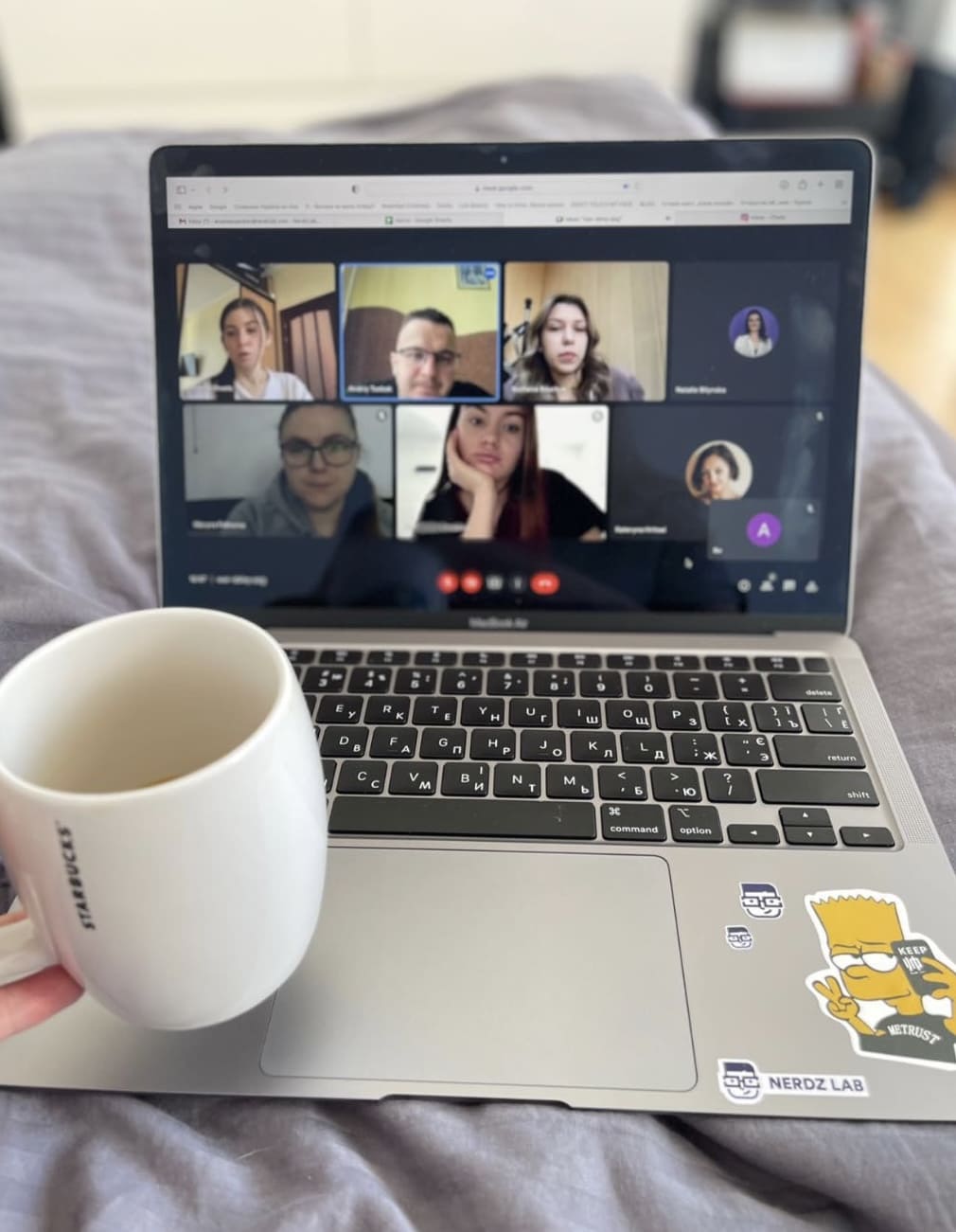От халепа... Ця сторінка ще не має українського перекладу, але ми вже над цим працюємо!

Remote doesn’t mean compromise: Managing remote teams like a pro

Andriy Tsebak
/
Co-Founder & BDM
12 min read
So you’re looking at software development outsourcing to take your business forward.
It’s a wise move, given the challenge of finding highly skilled engineers dedicated to your projects.
But whether you opt for a team extension, service expansion, or IT staff augmentation, you’ll soon be in a whole new world: managing remote software development teams.
The biggest fears startup owners and SMBs bring to the NERDZ LAB team are about quality maintenance, time zone differences, and cultural nuances. In this article, I’ll show you how to deal with each challenge and share practical tips on successfully managing a remote development project.
The good news is that remote work doesn’t have to be about compromise — all you need is a customized approach and a software development partner that can flex to suit your needs.
Watch my video on managing a remote team in software development on YouTube.

Article content:
- What you get with team extension services
- Managing remote teams: The main challenges
- Managing remote teams: Proven approaches for success
- Effective management strategies
- Managing a team with a remote project manager
- Time zones and scheduling
- Don’t worry about quality — control it
- Trust your vendor
- NERDZ LAB development stories
What you get with team extension services
As the name implies, team extension services extend your existing team with remote software developers. This popular model has several advantages to help your startup or growing business succeed.
- Access to global talent: With software development outsourcing, you can access a huge network of skilled professionals from around the globe with no geographic boundaries.
- Cost-effectiveness: Despite what some people think, outsourcing software development isn’t always the cheapest option. It does, however, bring several advantages that make it more cost-effective over time:
- Lower rates compared to local options
- Development experience and expertise
- Professional service quality
- A focus on core competencies: Delegating software development to a remote vendor gives you more time and energy to innovate, differentiate, and deliver value to customers without getting bogged down in the nitty-gritty of coding and development.
- Scalability and flexibility: Whether you’re experiencing rapid growth or not sure where your MVP will take you, the team extension model lets you scale your development team up or down quickly and efficiently.
This is all fantastic, but managing a remote software development team is still challenging, especially if you haven’t done it before. My main advice to newcomers is:
- Know and prepare for the challenges (forewarned is forearmed)
- Set up the right communication from the start
- Know which management strategies will get the best out of your team
- Don’t worry about quality, control it
- Trust your vendor
Let’s unpack each of these in turn.

See also: “Easier than you think”: NERDZ LAB’s CEO on developing AI apps
Managing remote teams: The main challenges
In my experience working with startups and business owners, one concern stands out: the fear of losing visibility and control over remote employees. But this apprehension is just the tip of the iceberg.
Let’s dive deeper into the top three fears I’ve encountered with NERDZ LAB clients before I explain how you can best address each one.
No physical oversight
Without physical oversight, how do you know your developers are giving all their time to your project? It’s no surprise that employers hesitate to trust employee productivity in hybrid or remote setups, even within the same company. Outsourcing software development adds another level of complexity in this context.
Communication barriers
Communication inefficiencies can cost a business over $12,000 per employee each year. Moreover, business leaders report their employees lose as much as eight hours per week due to communication breakdowns. And if you’re running a small company, these losses can hit particularly hard.
With software outsourcing companies, the primary concern regarding communication is whether extended team members possess a strong command of English. If they don’t, it can lead to all sorts of problems like misinterpreting requirements, unclear instructions, and struggles to explain complex technical stuff.
Plus, different communication styles and cultural norms can add another layer of concern, making it tough to ensure everyone is on the same page and working well together.
Poor team cohesion
In-person teams often bond naturally through shared breaks and after-work socializing. Building a similar sense of connection among remote employees is more challenging, which makes it difficult to gauge team cohesion and satisfaction.
Thankfully, remote team management isn’t all bad news — far from it. With the right strategies at your disposal, you can overcome these hurdles and get the best out of the team extension model.

See also: Team building in project management: Towards a non-toxic team collaboration.
Managing remote teams: Proven approaches for success
Here I’ll explore communication and management tactics, discuss methods for addressing time zone disparities, and emphasize the importance of fostering a supportive environment and maintaining quality control.
Communication strategies
Effective communication is key to ensuring seamless collaboration within remote teams. Here’s a streamlined approach:
Assess collaboration and communication needs
Start by identifying your remote team’s communication needs, considering factors such as team size, project complexity, and individual preferences. Have open discussions with your vendor about the challenges you see, whether it’s unclear communication channels, difficulty accessing shared resources, or potential cultural misunderstandings.
Finally, collaborate with your project or account manager to tailor solutions to meet your team’s specific requirements.
Set expectations
Establish clear communication protocols outlining preferred channels, expected response times, and meeting schedules to keep team members aligned. Document your processes to clear up any ambiguity and ensure everyone is on the same page.
Choose the right collaboration and communication tools
Finding the right tools for remote teamwork will boost your team’s efficiency and can significantly speed up your product’s time to market.
When choosing, prioritize accessibility, reliability, and user-friendliness for all team members. Here’s a breakdown of popular options and how to use them:
| Tool purpose | Example |
| Text-first communication
Set up separate channels for streamlined communication with the project manager or individual developers. |
Slack Microsoft Teams Discord |
| Video conferencing tools
Choose a platform that supports video and audio calls, screen sharing, virtual backgrounds, and chat messaging for daily meetings or standups. |
Google Meet Microsoft Teams Zoom |
| File storage and sharing
Use file-sharing platforms and real-time editing tools for access to the latest documents and simultaneous contributions, reserving emails for important documents, requests, and formalities. |
Google Drive Confluence Dropbox OneDrive SharePoint Gmail, Microsoft Outlook |
See also: From old to new: a guide to IT project handovers for businesses.
Establish clear guidelines for how you’ll use each communication channel to avoid confusion and ensure a seamless workflow.
Build a communication culture
Cultivate a culture of open communication and collaboration by encouraging team members to share ideas, provide feedback, and ask questions freely. Set up regular, brief project meetings to keep everyone in the loop and encourage the use of video to add a personal touch to virtual interactions.
Remember too that communication shouldn’t be all business — encourage informal chats and inside jokes to enhance creativity and strengthen bonds among team members.
Monitor progress
Provide training and guidance on effective communication practices, including virtual meeting etiquette, active listening skills, and written communication best practices. Continuously evaluate communication strategies by gathering feedback, then act on it to improve collaboration and productivity.

Effective management strategies
How you manage your team will depend on the type of software outsourcing services you’ve selected. At NERDZ LAB, our services include team extension, service extension, staff augmentation, and even CTO as a service. From a management perspective, though, the main difference is whether you manage the team yourself or hand over the reins to your remote partner.
Managing a remote team yourself
Here are the steps to ensure effective team collaboration if you or one of your employees is the project manager for a remote team.
Create a robust onboarding process
Introduce new remote developers to your in-house team and their departments and roles. Set up access to internal resources and establish preferred working styles, tools, and schedules to streamline collaboration.
Communicate your expectations clearly
Define project goals, timelines, milestones, and quality standards to ensure everyone is on the same page. Transparency is key in remote work, so highlight critical deadlines and dependencies to encourage proactive problem-solving and minimize delays.
Remember that these are general practices. Ensure that you tailor your communication style to your specific software development methodology and process.
Select an effective software development methodology
At NERDZ LAB, we mainly use the Agile approach, as it promotes close collaboration through short iterations. These typically last one to two weeks and involve regular meetings like daily standups and sprint planning. Agile also offers progress visibility via techniques like burndown charts. This helps your teams track progress and adapt as needed, especially across different time zones or with diverse responsibilities.
Build trust and offer continuous development
If you follow Agile, encourage team members to take ownership of their work and make decisions independently. Facilitate prompt feedback on each iteration or sprint to empower the team to refine their work autonomously. This approach means you can focus on managing processes rather than micromanaging every detail.
Development matters too. Give your new team the same training opportunities as in-house employees. Enhancing their skills will increase their contribution to your project. Consider attending conferences together and organizing team-building sessions to build connections in a relaxed environment.
Use the right collaboration tools
Your remote team’s efficiency hinges on having access to the right collaboration tools. When you manage the remote team yourself, you can choose the tools best suited for your team or individual engineers. Task management tools like Jira, ClickUp, Trello, and Asana align with Agile methodologies. Consider tools like Toggl Track, Clockify, or built-in platform trackers (like that in ClickUp) for accurate time tracking and progress monitoring.
You’ll also need to grant access to code management platforms such as GitHub, GitLab, or Bitbucket, which provide essential features like version control, CI/CD capabilities, code review, and seamless integration with other tools.
Your final collaboration toolset should ensure streamlined collaboration and efficient project management for your remote team.
Prioritize feedback and recognition
Show appreciation for your remote team’s efforts, achievements, and contributions. Use rewards, public praise, and incentives to celebrate successes. Prioritize team well-being by acknowledging birthdays and holidays and encouraging casual conversations in virtual meetings. Small tokens like company-branded gifts will prove your genuine interest and boost engagement and productivity.

See also: The team extension guide: how to do it properly.
Managing a team with a remote project manager
While it may seem daunting to hand over control of your remote team to someone else, it’s often the smart choice, especially if you need to concentrate on strategic business development. And it doesn’t have to be a worry: at NERDZ LAB, our project managers are seasoned technology experts adept at managing technology and project budgets, mitigating risks, ensuring quality, and managing expectations effectively.
Still, you’ll have your part to play. Follow these steps to ensure you get the most out of your remote team engagement.
Build rapport
Since your main contact will be the project manager at the vendor’s end, it’s important to establish a strong rapport with them. Instead of dealing directly with the entire team, the project manager will handle tasks like onboarding, tracking project milestones, providing feedback, and quality control.
Focus on establishing collaboration, respect, and transparency with your project manager. Make time for regular interactions, both formal and informal, using tools like video calls, chat groups, and virtual social events.
Needless to say, trust is key. Look for a vendor experienced in working with startups and small businesses who shows a solid understanding of your challenges. NERDZ LAB’s story describes our own startup journey.
Avoid micromanagement
It can be useful to document the boundaries between your role as the client and the project manager’s role as team lead. When you have a document for reference, it’s easier to avoid overstepping the mark or micromanaging tasks that are your PM’s responsibility.
Set up reporting and KPIs
Another way to avoid micromanagement is to emphasize outcomes and results. Define precise KPIs and milestones aligned with your project objectives. Use project management tools such as Jira or ClickUp to track progress and set clear expectations for the frequency and timing of reports.
Ask your vendor project manager to deliver succinct updates and promptly address issues. This approach fosters transparency and alignment across the team, minimizing the necessity for continuous oversight.
Time zones and scheduling
Time zone differences can also seem like a headache, but they’re manageable with the right approach, as the popularity of the software development outsourcing model shows. San Francisco is 10 hours behind Ukraine, but we have successfully delivered dozens of projects originating from Silicon Valley. Just follow these tips to ensure smooth collaboration with your remote team.
- Establish your time window(s): Identify the time(s) when both you and your remote team can communicate effectively. This could be your early morning and their early evening, allowing for two or three hours of shared working time.
- Adjust working hours: Consider asking your remote team to shift their hours to better align with yours. At NERDZ LAB, we’ve accommodated client requests this way on many projects.
- Share meeting recordings and notes: Record important meetings or share detailed notes with team members who couldn’t attend. This ensures everyone stays informed and can catch up on any missed discussions.
- Coordinate critical events: Discuss in advance with your vendor when you’ll need their support for events like product demos or conferences. Be flexible and offer compensation for any inconvenience caused by unusual scheduling.
- Turn time differences into an advantage: You can also use time zone differences to maximize around-the-clock efficiency. For example, developers ahead of your time zone can work on tasks overnight, which means you can review their work and provide feedback the next day.
With proper planning, effective communication tools, and clear expectations, you can overcome the challenges of remote collaboration across different time zones.
Don’t worry about quality — control it
Great communication and management processes mean you’re well on your way to working successfully with your remote team. But how can you guarantee that the product you expect meets your high standards? Here are some pointers.
Set clear quality standards
Define precise quality standards and criteria for your project from the outset. These standards should reflect your company’s brand values and customer expectations. Ensure your remote team understands and embraces these standards to deliver a product your target audience will love.
Review vendor’s quality assurance procedures
Take the time to review the vendor’s quality assurance procedures and methodologies. Inquire about their approach to testing, bug tracking, and resolution processes. Look for thorough testing procedures, including unit tests, integration tests, and user acceptance testing (UAT).
Pay attention to modern approaches like automated testing and CI/CD (continuous integration and continuous delivery) to catch and fix issues quickly. You can learn more about how NERDZ LAB ensures top-notch quality in client deliveries here.
Conduct regular quality audits
Implement periodic quality audits to evaluate the ongoing quality of deliverables from the vendor. Review code repositories, test results, and documentation carefully to ensure they meet your quality standards. Promptly address any identified quality issues or shortcomings.

See also: Everything you need to know about mobile application development lifecycle
Trust your vendor
The story and tips I’ve shared here have been accumulated through years of working at NERDZ LAB, a software development company in Ukraine whose clients are from regions stretching from the US and Europe to Asia and Australia. We’ve supported different engagement models, including dedicated teams, with some projects even incorporating a fractional CTO.
Will these practices work for you? The answer will partly lie with your vendor since software outsourcing services, like any business relationship, require effort from both sides.
At NERDZ LAB, we offer the following to make sure our clients are more than satisfied with our team extension services:
- Clear communication and development processes. We don’t just establish clear communication channels and detailed documentation; we aim to know more about the bigger picture, what our clients strive for with each project, and the vision they’re trying to build.
- A Scandinavian-inspired approach. Scandinavian management follows a flat organizational model, prioritizing people rather than rigid hierarchies. Unlike traditional structures that concentrate power in the hands of a few, we value autonomy and flexibility in our workspace and schedules.
- Top talent. We’re picky about the people we cooperate with and the projects we take on. Our management model, which prioritizes employee well-being and treats them as accountable professionals, naturally attracts talent from other organizations through positive word-of-mouth referrals.
- Deep expertise. Our focus on startups and small businesses, along with short-term projects, has given us plenty of experience with new technologies. We do prioritize innovation, trying to steer clear of old code, fixing others’ mistakes, and outdated tech.
But as always, actions speak louder than words. Want to see some successful remote projects we’ve completed?
NERDZ LAB development stories
Let’s take a look at NERDZ LAB’s track record in providing development team extension services.
- One of our biggest remote team projects is TruConnect for a UK client. The app and SaaS platform grew out of the project Tona, which was acquired by a new company. We continued our collaboration with the new owner, offering our product design, web development, and mobile application development services. We have been supporting the app’s success since 2020.
- Blank AI is a captivating project for a seasoned entrepreneur from the US. Our partnership spans several years, during which we’ve collaborated on several successful ventures. With our remote team seamlessly integrated, we’ve brought many of this client’s visionary ideas to life.
- The WhatSalon project (Ireland) began with a small team of iOS app developers but expanded into a full-cycle software product development project over time. As it evolved and required deeper engineering insights, the client enlisted the expertise of a Chief Technology Officer (CTO), a role fulfilled by a NERDZ LAB expert. Ultimately, the project was sold for over €15 million.
- Subit, a Danish company, had its own in-house developers but needed additional expertise to scale and support its SaaS project. After careful consideration, they chose NERDZ LAB and successfully worked with our team of one back-end and three front-end developers to streamline their web development services.
You can check out more of our completed projects here.
And we’re done! I hope my explanations have answered your questions about managing remote teams. If you plan to outsource software development and want to discuss our services further, you can set up a free consultation here. Also, I am happy to connect on LinkedIn. We’d love to talk!





